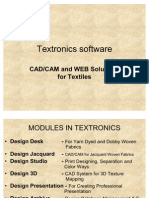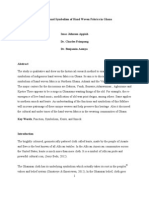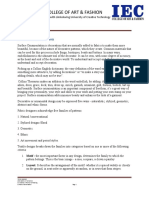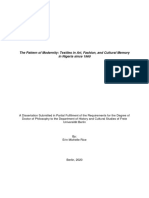African Wax Prints - Wikipedia
African Wax Prints - Wikipedia
Uploaded by
Pictop TixCopyright:
Available Formats
African Wax Prints - Wikipedia
African Wax Prints - Wikipedia
Uploaded by
Pictop TixCopyright
Available Formats
Share this document
Did you find this document useful?
Is this content inappropriate?
Copyright:
Available Formats
African Wax Prints - Wikipedia
African Wax Prints - Wikipedia
Uploaded by
Pictop TixCopyright:
Available Formats
African wax prints - Wikipedia https://en.wikipedia.
org/wiki/African_wax_prints
African wax prints
African wax prints, Dutch wax prints[1][2] or Ankara,[3] are omnipresent and common materials for
clothing in West Africa and Central Africa. They were introduced to West and Central Africans by Dutch
merchants during the 19th century, who took inspiration from native Indonesian technique and Akwete
cloth designs.[4] They began to adapt their designs and colours to suit the tastes of the African market.
They are industrially produced colorful cotton cloths with batik-inspired printing.[5] One feature of these
materials is the lack of difference in the color intensity of the front and back sides. The wax fabric can be
sorted into categories of quality due to the processes of manufacturing.
Normally, the fabrics are sold in lengths of 12 yards (11 m) as "full piece" or 6 yards (5.5 m) as "half piece".
The colors comply with local preferences of the customers. Typically, clothing for celebrations is made African waxprints, West Africa
from this fabric.
Wax prints are a type of nonverbal communication among African women, and thereby carry their
messages out into the world. Some wax prints are named after personalities, cities, buildings, sayings, or
occasions. The producer, name of the product, and registration number of the design is printed on the
selvage, thus protecting the design and attesting to the quality of the fabric. Wax fabrics constitute capital
goods for African women. They are therefore often retained based on their perceived market value.
In Sub-Saharan Africa these textiles have an annual sales volume of 2.1 billion yards, with an average
production cost of $2.6 billion and retail value of $4 billion.[6]
Waxprints sold in a shop in West
Ghana has an annual consumption of textiles of about 130 million yards (120 million metres). The three Africa
largest local manufacturers, Akosombo Textiles Limited (ATL), Ghana Textiles Print (GTP), and Printex,
produce 30 million yards, while 100 million yards come from inexpensive smuggled Asian imports.[7]
The Vlisco Group, owner of the Vlisco, Uniwax, Woodin, and GTP brands, produced 58.8 million yards
(53.8 million meters) of fabric in 2011. Net sales were €225 million, or $291.65 million.[8] In 2014, Vlisco's
70 million yards of fabric (about 64 million meters) were produced in the Netherlands, yielding a turnover
of €300 million.[9]
Contents Lady selling colorful waxprint fabrics
in Togo
History
Wax print cloth production
Wax print manufacturers
African fancy print
See also
References
Literature "Afrika im Gewand - Textile
Kreationen in bunter Vielfalt",
African Textiles Exhibition Museum
History der Völker 2016
The process to make wax print is originally influenced by batik, an Indonesian (Javanese) method of
dyeing cloth by using wax-resist techniques. For batik, wax is melted and then patterned across the blank cloth. From there, the cloth is soaked
in dye, which is prevented from covering the entire cloth by the wax. If additional colors are required, the wax-and-soak process is repeated
with new patterns.
During the Dutch colonization of Indonesia, Dutch merchants and administrators became familiar with the batik technique. Thanks to this
contact, the owners of textile factories in the Netherlands, such as Jean Baptiste Theodore Prévinaire[10]:16 and Pieter Fentener van
Vlissingen,[11] received examples of batik textiles by the 1850s if not before, and started developing machine printing processes which could
imitate batik. They hoped that these much cheaper machine-made imitations could outcompete the original batiks in the Indonesian market,
effecting the look of batik without all the labor-intensive work required to make the real thing.
Prévinaire's attempt, part of a broader movement of industrial textile innovation in Haarlem, was the most successful. By 1854[10]:16–17 he had
modified a Perrotine, the mechanical block-printing machine invented in 1834 by Louis-Jérôme Perrot, to instead apply a resin to both sides
of the cloth.[12]:20 This mechanically applied resin took the place of the wax in the batik process.
Another method, used by several factories including Prévinaire's[10]:18,20 and van Vlissingen's,[11] used the roller printing technology invented
in Scotland in the 1780s.
Unfortunately for the Dutch, these imitation wax-resist fabrics did not successfully penetrate the batik market. Among other obstacles, the
imitations lacked the distinctive wax smell of the batik fabric.[10]:17–18
Starting in the 1880s,[11][10]:47,50 they did, however, experience a strong reception in West Africa when Dutch and Scottish trading vessels
began introducing the fabrics in those ports. Initial demand may have been driven by the taste for batik developed by the Belanda Hitam, West
Africans recruited between 1831 and 1872 from the Dutch Gold Coast to serve in the Dutch colonializing army in Indonesia. Many members of
the Belanda Hitam retired to Elmina, in modern Ghana, where they may have provided an early market for Dutch imitation batik.[10]:41–46
1 of 3 21 Jun 2022, 13:24
African wax prints - Wikipedia https://en.wikipedia.org/wiki/African_wax_prints
The success of the trade in West Africa prompted other manufacturers, including Scottish, English, and Swiss manufacturers, to enter the
market.
The Dutch wax prints quickly integrated themselves into African apparel, sometimes under names such as “Veritable Dutch Hollandais,” and
“Wax Hollandais”. Women used the fabrics as a method of communication and expression, with certain patterns being used as a shared
language, with widely understood meanings. Many patterns began receiving catchy names. Over time, the prints became more African-
inspired, and African-owned by the mid-twentieth century. They also began to be used as formal wear by leaders, diplomats, and the wealthy
population.
Wax print cloth production
Prévinaire's method for the production of imitation batik cloth proceeds as follows. A block-printing machine applies resin to both sides of the
fabric. It is then submerged into the dye, in order to allow the dye to repel the resin covered parts of the fabric. This process is repeated, to
build up a coloured design on the fabric. Multiple wooden stamp blocks would be needed for each colour within the design. The cloth is then
boiled to remove the resin which is usually reused.[13]
Sometimes the resin on the cloth can be crinkled in order to form cracks or lines that are known as "crackles". The English- and Dutch-
produced fabrics tended to have more cracking in the resin than those produced in Switzerland.[13] Due to the lengthy stages of its production,
wax prints are more expensive to make than other commercial printed fabrics but their finished designs are clear on both sides and have
distinct colour combinations.[12]:15
Wax print manufacturers
After a merger in 1875, the company founded by Prévinaire became Haarlemsche Katoenmaatschappij (Haarlem Cotton Company). The
Haarlemsche Katoenmaatschappij went bankrupt during the First World War, and its copper roller printing cylinders were bought by van
Vlissingen's company.[10]:20–21,59
In 1927, van Vlissingen's company rebranded as Vlisco.
Before the 1960s most of the African wax fabric sold in West and Central Africa was manufactured in Europe. Today, Africa is home to the
production of high quality wax prints.[14] Manufacturers across Africa include ABC Wax, Woodin, Uniwax, Akosombo Textiles Limited (ATL),
and GTP (Ghana Textiles Printing Company), the latter three being part a part of the Vlisco Group.[15] These companies have helped reduce
the prices of African wax prints in the continent when compared to European imports.
African fancy print
The costly produced wax fabrics are increasingly imitated by alternative ways of manufacturing. The so-called "fancy fabrics" are produced in a
printing procedure. Costly designs are printed digitally.
Fancy fabrics in general are cheap, industrially produced imitations of the wax prints and are based on industry print. Fancy fabrics are also
called imiwax, Java print, roller print, le fancy or le légos. These fabrics are produced for mass consumption and stand for ephemerality and
caducity. Fancy Fabrics are more intense and rich in colors than wax prints and are printed on only one side.
As for wax prints, producer, product name and registration number of the design are printed on the selvage. Even the fancy fabrics vary with a
certain fashion. The fabrics are limited to amount and design and are sometimes exclusively sold in own shops.
At first the fancy prints were made with engraved metal rollers but more recently they are produced using rotary screen-printing process.[14]
The production of these imitation wax print fabrics, allow those who cannot afford the European imported wax prints to be able to purchase
them. The fancy print designs often mimic or copy the designs of existing wax print designs but as they are cheaper to make, manufacturers
tend to take risks and experiment with new designs.[14]
See also
Wrapper (clothing)
Shweshwe
Kitenge
References
1. Sylvanus, Nina. "West Africans ditch Dutch wax prints for Chinese 5. Gerlich 2004, p. 1.
'real-fakes' " (https://theconversation.com/west-africans-ditch-dutc 6. "In textile industry, a hidden goldmine" (https://guardian.ng/feature
h-wax-prints-for-chinese-real-fakes-59846). The Conversation. s/youthspeak/in-textile-industry-a-hidden-goldmine/). In textile
Retrieved 2021-11-19. industry, a hidden goldmine. Retrieved 2018-05-20.
2. " 'This has never been so much fun!': Royal Academy Summer 7. "Textile industry needs attention to boost local manufacturing" (htt
Exhibition review" (https://www.theguardian.com/artanddesign/202 ps://web.archive.org/web/20170919055925/https://www.myjoyonli
1/sep/16/fun-royal-academy-summer-exhibition-review-yinka-shon ne.com/business/2017/september-19th/textile-industry-needs-atte
ibare). The Guardian. 2021-09-16. Retrieved 2021-11-19. ntion-to-boost-local-manufacturing.php). Textile industry needs
3. "900+ Ankara ideas in 2022 | african clothing, african fashion attention to boost local manufacturing. Archived from the original
dresses, african dress" (https://www.pinterest.com/atinukecole/an (https://www.myjoyonline.com/business/2017/september-19th/texti
kara/). Pinterest. Retrieved 2022-06-09. le-industry-needs-attention-to-boost-local-manufacturing.php/) on
4. "A PIECE OF HISTORY- THE AKWETE FABRIC" (https://guardia 2017-09-19. Retrieved 2018-05-20.
n.ng/life/culture-lifestyle/a-piece-of-history-the-akwete-fabric/). 8. "Africa's Fabric Is Dutch" (https://www.nytimes.com/2012/11/15/fa
Retrieved 5 December 2016. shion/15iht-ffabric15.html/). New York Times. November 15, 2012.
Retrieved May 20, 2018.
2 of 3 21 Jun 2022, 13:24
African wax prints - Wikipedia https://en.wikipedia.org/wiki/African_wax_prints
9. "Wax prints, like Vlisco, are still making believe that they are 13. Gillow, John (2009). Printed and Dyed textiles from Africa.
African" (https://yen.com.gh/86744-wax-prints-vlisco-making-afric London: The British Museum Press. p. 18.
an.html#86744/). Yen.com.gh. Retrieved 2018-05-20. 14. Magie, Relph; Irwin, Robert (2010). African wax print: a textile
10. Kroese, W.T. (1976). The origin of the Wax Block Prints on the journey. Meltham: Words and Pixels for the African Fabric Shop.
Coast of West Africa. Hengelo: Smit. ISBN 9062895018. p. 32. ISBN 9780956698209. OCLC 751824945 (https://www.worl
11. "The Founding of Vlisco" (https://www.vlisco.com/heritage/the-fou dcat.org/oclc/751824945).
nding-of-vlisco/). Vlisco. Retrieved 2017-09-25. 15. "About GTP - GTP Fashion" (http://gtpfashion.com/about-gtp/).
12. LaGamma, Alisa (2009). The Essential Art of African Textiles: GTP Fashion. Retrieved 2017-09-25.
Design Without End. New York: The Metropolitan Museum of Art.
Literature
Gerlich, G. (2004). Waxprints im soziokulturellen Kontext Ghanas. Arbeitspapier Nr. 54 (https://web.archive.org/web/20131004215541/htt
p://www.ifeas.uni-mainz.de/workingpapers/AP54nurtext.pdf) (PDF). Institut für Ethnologie und Afrikastudien. Johannes Gutenberg
Universität Mainz. Archived from the original (http://www.ifeas.uni-mainz.de/workingpapers/AP54nurtext.pdf) (PDF) on 2013-10-04.
Gillow, J. (2003). African textiles. Colour and creativity across a continent. London: Thames & Hudson Ltd.
Joseph, M. L.: Introductory Textile Science. 2. Aufl. New York: Holt, Rinehart and Winston, 1972
Luttmann, I. (2005). "Die Produktion von Mode: Stile und Bedeutungen". In Luttmann, Ilsemargret (ed.). Mode in Afrika. Mode als Mittel der
Selbstinszenierung und Ausdruck der Moderne. Museum für Völkerkunde Hamburg. pp. 33–42.
Picton, J. (1995). "Technology, tradition and lurex: The art of textiles in Africa". In Picton, John (ed.). The art of African textiles. Technology,
tradition and lurex. London: Lund Humphries Publishers. pp. 9–32, 132.
Rabine, Lesley W. (1 November 2002). The global circulation of African fashion. Oxford: Berg. ISBN 978-1-85973-598-5.
Schädler, Karl F. (1997). Afrikanische Kunst. Von der Frühzeit bis heute [African Art. From the early days until today] (in German). Munich:
Wilhelm Heyne Verlag. ISBN 9783453130456.
Sarlay A., Jurkowitsch, S.: „Entdecken der Vorarlberger Stickereien in Westafrika“, Wirtschaftskammer Vorarlberg, 2009
Sarlay, A.; Jurkowitsch, S. "An analysis of the current denotation and role of Wax & Fancy fabrics in the world of African textiles".
International Journal of Management Cases. 1/2010 (22): 28–48.
Storey, J. (1974). Manual of Textile Printing. New York: Van Nostrand Reinhold Company.
Koné, F. B. (2000). "Das Färben von Stoffen in Bamako". In Gardi, Bernhard (ed.). Boubou c´est chic. Gewänder aus Mali und anderen
Ländern Westafrikas. Museum der Kulturen Basel (in German). Basel: Christoph Merian Verlag. pp. 164–171.
Retrieved from "https://en.wikipedia.org/w/index.php?title=African_wax_prints&oldid=1093851435"
This page was last edited on 19 June 2022, at 06:07 (UTC).
Text is available under the Creative Commons Attribution-ShareAlike License 3.0; additional terms may apply. By using this site, you agree to the Terms of Use and
Privacy Policy. Wikipedia® is a registered trademark of the Wikimedia Foundation, Inc., a non-profit organization.
3 of 3 21 Jun 2022, 13:24
You might also like
- African Wax Print Textiles (Muestra)Document25 pagesAfrican Wax Print Textiles (Muestra)María71% (7)
- BonpointDocument24 pagesBonpointCamillaNo ratings yet
- ADIREDocument8 pagesADIREAfolabi Victor100% (2)
- African Fashion On Global StaageDocument6 pagesAfrican Fashion On Global StaageUmber XahidNo ratings yet
- African Fashion On Global StaageDocument6 pagesAfrican Fashion On Global StaageUmber XahidNo ratings yet
- Eed WigDocument8 pagesEed WigSeye KareemNo ratings yet
- WestAfricanTextiles PDFDocument33 pagesWestAfricanTextiles PDFsuerock100% (1)
- Event Proposal Womens ShowDocument5 pagesEvent Proposal Womens Showapi-339830575No ratings yet
- Denim Fading 2Document10 pagesDenim Fading 2Delwar HossainNo ratings yet
- Africa HandicraftDocument17 pagesAfrica HandicraftAmrutha RP100% (1)
- UntitledDocument36 pagesUntitledMaryNo ratings yet
- Ankara Native WearsDocument30 pagesAnkara Native WearsCOGENT MULTITECH LIMITED100% (1)
- Fabric Design SoftwareDocument34 pagesFabric Design SoftwareSentthil Kumar100% (1)
- Deconstructing The Concept of 'African Print' in The Ghanaian ExperienceDocument16 pagesDeconstructing The Concept of 'African Print' in The Ghanaian ExperienceNayaneFontes100% (1)
- The Power of NetworkingDocument12 pagesThe Power of Networkingapi-400197296No ratings yet
- An Enterprise Map of Ethiopia (LSE RO) PDFDocument206 pagesAn Enterprise Map of Ethiopia (LSE RO) PDFAnonymous oYmn3kNo ratings yet
- Free Fashion CoursesDocument1 pageFree Fashion CoursesAdminp PagesaNo ratings yet
- Raw MaterialsDocument104 pagesRaw MaterialsGarima Bhatia100% (1)
- Networking: Tips & StrategiesDocument5 pagesNetworking: Tips & Strategies7lightbourn5893No ratings yet
- Function and Symbolism of KenteDocument24 pagesFunction and Symbolism of KenteIsaac Johnson Appiah100% (1)
- Anakaputhur Weaver's AssociationDocument62 pagesAnakaputhur Weaver's AssociationExigencyfor Words100% (1)
- BagruDocument7 pagesBagruKriti KumariNo ratings yet
- Fashion Source BookDocument10 pagesFashion Source Bookalankriti12345No ratings yet
- Your Wedding 2014Document9 pagesYour Wedding 2014The Myanmar Times100% (1)
- A Twisty Tales: (Hair Braiding)Document14 pagesA Twisty Tales: (Hair Braiding)Anne Rose Encina50% (2)
- Batik PrintingDocument5 pagesBatik Printingpandey06.anoopNo ratings yet
- Case AnalysisDocument25 pagesCase Analysisdrupad parmarNo ratings yet
- Textiles and Clothing ManufacturingDocument42 pagesTextiles and Clothing ManufacturingZubair Shafqat0% (1)
- State of Traditional Attires Usage Among The Contemporary Society in South-West NigeriaDocument12 pagesState of Traditional Attires Usage Among The Contemporary Society in South-West NigeriaOlapade Babatunde100% (1)
- Ikat or IkkatDocument5 pagesIkat or IkkatDevanshi DabriwalNo ratings yet
- Kuba ClothDocument1 pageKuba Clothmagoye100% (2)
- Sonia Ali Roll No 43 BS 8th SemesterDocument13 pagesSonia Ali Roll No 43 BS 8th SemesterSonia AliNo ratings yet
- Portfolio 2 PDFDocument10 pagesPortfolio 2 PDFPrachi DhakaNo ratings yet
- Gemseal Face Care Collection PDFDocument8 pagesGemseal Face Care Collection PDFSari RamadhaniNo ratings yet
- Marking ToolsDocument1 pageMarking ToolsRAMON ENRIQUEZ HIGH SCHOOLNo ratings yet
- Batik and Banjara EmbroideryDocument34 pagesBatik and Banjara Embroideryvidhi sahu100% (1)
- Different Type of FabricsDocument10 pagesDifferent Type of FabricsClark ken ReductoNo ratings yet
- Fabric TerminologyDocument20 pagesFabric TerminologyRasel MahmudNo ratings yet
- Apparel Merchandising - Types of BuyersDocument24 pagesApparel Merchandising - Types of BuyersNithyaprakashNo ratings yet
- Handicraft Printing in RajasthanDocument16 pagesHandicraft Printing in RajasthanGopal DixitNo ratings yet
- Iec College of Art & Fashion: Surface OrnamentationDocument13 pagesIec College of Art & Fashion: Surface OrnamentationMahek AgrawalNo ratings yet
- Tie DyeDocument19 pagesTie Dyenomcebo dlamini100% (1)
- CHAPTER 1 Sumerian ClothingDocument15 pagesCHAPTER 1 Sumerian ClothingJose KouassiNo ratings yet
- Tie Dye Project ReportDocument18 pagesTie Dye Project ReportShan AtrayNo ratings yet
- Care LabelsDocument24 pagesCare LabelsV B NagarajanNo ratings yet
- African Origin Style MapDocument1 pageAfrican Origin Style MapVishal KediaNo ratings yet
- Textiles and ApparelDocument346 pagesTextiles and ApparelSanJana NahataNo ratings yet
- For Other Uses, See: Batik (Javanese PronunciationDocument18 pagesFor Other Uses, See: Batik (Javanese PronunciationRama Arumugam RamaNo ratings yet
- Design: StudioDocument6 pagesDesign: StudioWendy MckayNo ratings yet
- Kalamkari PaintingDocument12 pagesKalamkari Paintingsandeep_karatNo ratings yet
- Fashion and Beauty Trends in The 20th CenturyDocument18 pagesFashion and Beauty Trends in The 20th CenturyLianaNo ratings yet
- The Wig Theory PowerpointDocument11 pagesThe Wig Theory PowerpointfahdfarooqNo ratings yet
- Beauty Event CatalogueDocument31 pagesBeauty Event CatalogueShanty ManekNo ratings yet
- Draping: Created By-Pragati RastogiDocument17 pagesDraping: Created By-Pragati RastogiPragati RastogiNo ratings yet
- 1 A.textile SegmentsDocument28 pages1 A.textile SegmentsanushkaNo ratings yet
- Hand Printed FabricsDocument29 pagesHand Printed FabricsAyesha AhmadNo ratings yet
- Vandana RajDocument29 pagesVandana RajUsha paliNo ratings yet
- Bridal Buyer May Jun 2013Document112 pagesBridal Buyer May Jun 2013mohzgoNo ratings yet
- Denim Manufecturing Process PDFDocument22 pagesDenim Manufecturing Process PDFadeel0523261No ratings yet
- SMEDA Hand Made Carpet ManufacturingDocument25 pagesSMEDA Hand Made Carpet ManufacturingAbbas SaleemianNo ratings yet
- CONVERSION OF CLASSICAL PRINTS INTO CONTEMPORARY PRINT ADocument13 pagesCONVERSION OF CLASSICAL PRINTS INTO CONTEMPORARY PRINT ABishop GilbertNo ratings yet
- PRODUCTIONOFDINNERWEARFORFEMALEYOUNGADULTBETWEENTHEAGESOF25TO30YEARSTOATTENDADINNERPARTYDocument62 pagesPRODUCTIONOFDINNERWEARFORFEMALEYOUNGADULTBETWEENTHEAGESOF25TO30YEARSTOATTENDADINNERPARTYAugustineNo ratings yet
- Fashion Business PlanDocument53 pagesFashion Business PlanJey MaxNo ratings yet
- RICE The Pattern of Modernity Nigeria Thesis 2020Document237 pagesRICE The Pattern of Modernity Nigeria Thesis 2020Miriam Ali de UnzagaNo ratings yet
- Waliu Project Work Real OneDocument46 pagesWaliu Project Work Real OneBadmus YussufNo ratings yet
- African Craft: Rashmi Srivastava B.VOC SEM - (VTH)Document33 pagesAfrican Craft: Rashmi Srivastava B.VOC SEM - (VTH)Ritesh SrivastavNo ratings yet
- Ebi The Star WorkDocument28 pagesEbi The Star WorkokechukwubenzionNo ratings yet
- Deconstructing The Concept of 'African Print' in The Ghanaian ExperienceDocument16 pagesDeconstructing The Concept of 'African Print' in The Ghanaian ExperienceNayaneFontes100% (1)
- Chiomahjvl HKJDocument19 pagesChiomahjvl HKJokechukwubenzionNo ratings yet
- THE Emcee SCRIPTDocument3 pagesTHE Emcee SCRIPTArmanVerseNo ratings yet
- African Wax Prints - WikipediaDocument3 pagesAfrican Wax Prints - WikipediaPictop TixNo ratings yet




































































